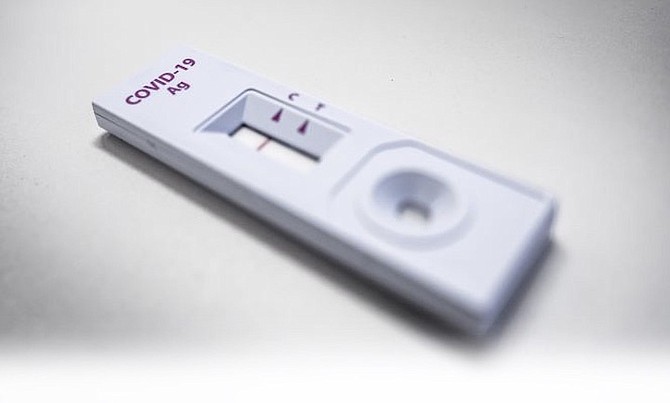BETWEEN December 23 and December 25, 580 new cases of COVID-19 were recorded. This should come as no surprise given the gatherings that usually takes place during the holidays and the few restrictions that were in place. There should have been better measures to protect against rampant spread of COVID-19, especially given what we already know about the Omicron variant.
According to the World Health Organization (WHO), Omicron is spreading faster than previous strains. While it is still too early to tell whether or not Omicron causes more severe illness or symptoms, it appears as though the common symptoms are cough, runny nose, congestion and fatigue. One possible reason for its rapid spread is that it is being mistaken for the common cold or flu. It is not safe, during this pandemic, to make any assumptions or self-diagnose when these symptoms present themselves. We need to be careful, to self-isolate at the onset of symptoms, alert our contacts and seek testing.
We need to have better access to testing at this stage. Testing is being offered in many locations, but the cost is a barrier for many. A rapid antigen test costs about $30 and a PCR test costs more than $100 each. The PCR tests have greater sensitivity than the rapid antigen tests, so a PCR test is the preferred option for testing for current infection. Increasingly, PCR tests are becoming the requirement for international travel. To enter Trinidad & Tobago, for example, a negative PCR test result is required of both unvaccinated and vaccinated travellers.
Anecdotal evidence shows vaccinated people often test negative in the first few days of a COVID- 19 infection. This is due to the immune-response mounted by their bodies. The virus takes a longer time to be registered on tests than it takes for symptoms to start, so those who have symptoms and test negative are advised to test again a few days later. There have been many accounts of people who first tested negative, then tested positive three or more days later.
One person reported she tested negative seven times in six days — six rapid tests and one PCR test — before testing positive on an at-home rapid test.
It has been explained that symptoms are a part of the immune response. The vaccine causes the virus to be detected by the body earlier, before the virus grows. This fast response helps to suppress the virus and, as a result, symptoms show up before vaccinated people become contagious. The rapid antigen test comes back positive when people are infectious and the PCR test shows the presence of the virus beyond the immediate infectious period. This is the reason PCR tests are often preferred.
In the UK, free rapid lateral flow tests are available and people are encouraged to self-test twice per week. Test kits can be collected from pharmacies as well as other locations and they can also be ordered online. Making these tests widely available encourages people to test and enables earlier detection which can help to reduce the spread of COVID-19. During the holidays, for example, if people are already in the habit of testing regularly and have records of their results, it is much easier to make decisions about gatherings.
Many people have committed to testing, isolating and testing again a few days later before joining another household for festivities. We can do the same, but we would have to pay for two tests per person. This is generally not a cost many people want to absorb, especially at a time when they prefer to spend money on gifts and other holiday items.
The decision to stop giving permission for large gatherings is a good one, but has come quite late. It is also not going to make people more cautious as they make decisions about mixing households for long periods of time in indoor settings. The risk factors need to be stated, over and over again, and the government needs to make it easier for people to test, and at a lower cost. Those who can afford it need to be test repeatedly before and after gathering. Those who cannot afford it should exercise personal responsibility, but should also have other options.
We may be tired of the pandemic, but it is still here. We may not be hearing about dire cases every day, but they do exist. There are still many people among us who are not vaccinated. The virus continues to spread and people continue to gather.
One sad truth is some people will only exercise caution if they or someone they know tests positive. There are steps we can take as individuals to keep ourselves safe and help to protect one another, but the government has a responsibility too. That includes setting protocols in line with the latest information and advice from medical professionals and making testing not only available, but accessible to the public.
ALTERNATIVES TO LARGE NEW YEAR’S EVE/DAY GATHERINGS
1. Family game night. Most board games require between two and four players as a minimum, so you are sure to find options for even a small household. Try a few games you haven’t played in a long time. Monopoly, Checkers, and Connect Four are a good start. Get a deck of cards, and there are lots of options from the child-friendly game of matching to the much more intense spades. There are also many two-player games that are fun to watch, particularly for those who are just learning or already love games like chess and backgammon.
2. Karaoke. You don’t need to be in a bar or restaurant to sing your heart out, whether you’re a great talent or have the worst track record of remembering song lyrics or staying in tune. Karaoke is entertainment for everyone, and it can happen anywhere. You need only search for the karaoke version of songs on Youtube to get your family started. Use a computer, pass around a mobile device, or get it streaming on a smart television for an evening of music and laughter.
3. Television show marathons. Life gets hectic, and the list of television shows we want to watch gets longer and longer. Sometimes we completely forget until the season is finished. Sometimes it is years later that we remember we never watched that one show everyone was talking about when we were too busy to pay attention. Even better, we sometimes remember television shows we loved that no one else in the house seems to have ever watched. New Year’s Eve and/or New Year’s Day can be perfect for catching up or revisiting. Catch the latest season of Insecure, go back and watch Family Matters from the beginning, or check out a reboot to see if it stands up to the original.
4. Family Bakeoff. For this one, it is probably best to team up so there isn’t too much chaos in the kitchen. For the amateurs, chocolate chip cookies may be a good place to start. For those who are used to baking, pies and breads may be more interesting. If you really want a challenge, do a quick search to see what the contestants on The Great British Bakeoff have had to do over the years. If baking seems like a bit much, you may want to try a cook-off instead. It can be as simple as scrambled eggs (which, you may know, can also get quite fancy). Design the challenges to suit your family and the skill level of each person or team.






Comments
Use the comment form below to begin a discussion about this content.
Sign in to comment
Or login with:
OpenID